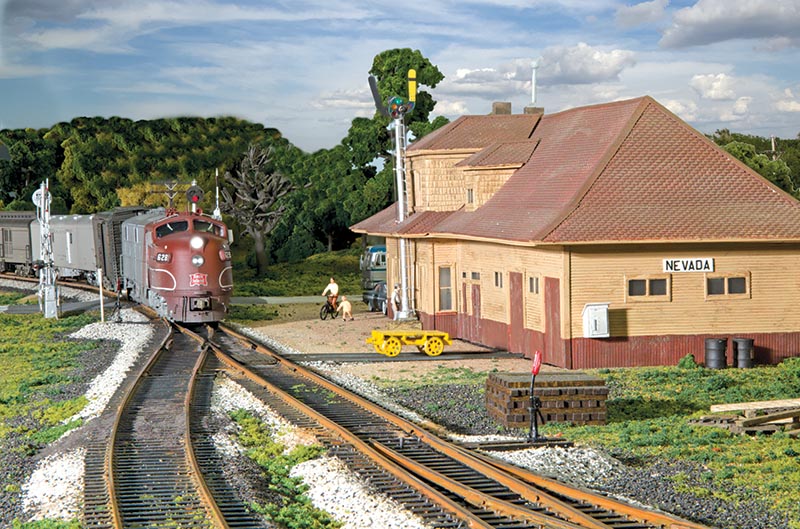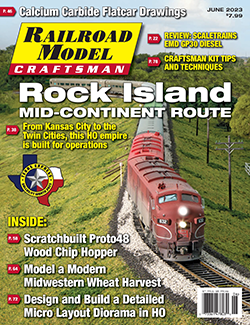 After decades of struggle, the Chicago, Rock Island & Pacific ended operations on March 31, 1980. Gone was a railroad that many dedicated employees had diligently worked on to keep its Rocket passenger trains and fast freights rolling safely and reliably throughout its 14-state network. From 1852 to 1980, the Rock Island experienced many ups and downs. The railroad survived a few bankruptcies during its life and yet managed to continue operating. In the end, an unsuccessful (and delayed) merger proposal with Union Pacific, deferred maintenance, labor issues, excessive branch line miles, and several other factors of the postwar economy resulted in the Rock Island’s ultimate demise. The once “mighty good road” was now relegated to the history books.
After decades of struggle, the Chicago, Rock Island & Pacific ended operations on March 31, 1980. Gone was a railroad that many dedicated employees had diligently worked on to keep its Rocket passenger trains and fast freights rolling safely and reliably throughout its 14-state network. From 1852 to 1980, the Rock Island experienced many ups and downs. The railroad survived a few bankruptcies during its life and yet managed to continue operating. In the end, an unsuccessful (and delayed) merger proposal with Union Pacific, deferred maintenance, labor issues, excessive branch line miles, and several other factors of the postwar economy resulted in the Rock Island’s ultimate demise. The once “mighty good road” was now relegated to the history books.
I was fortunate to have witnessed some decent years of operation on the Rock Island in and around Nevada, Iowa, where I was a young railroad enthusiast in the 1960s. That is the time period that left the biggest impression on me of the Rock Island. By the early 1970s, the railroad’s physical plant was deteriorating and I refer to the 1970 to 1980 time period as the “decade of decline” for the Rock Island.
Although blue and white locomotives and a new logo were introduced in 1974 to bolster its public image, in reality this seemed to have little positive impact on keeping the railroad afloat. It didn’t take long for the blue-and-white locomotives to be covered in road grime and oil. Soon after its introduction, the blue was labeled within the railroad and railfan community as “bankruptcy blue.” I am not opposed to the new image look, but with my modeling period of 1964 to 1974 I have chosen to preclude any blue-and-white equipment.
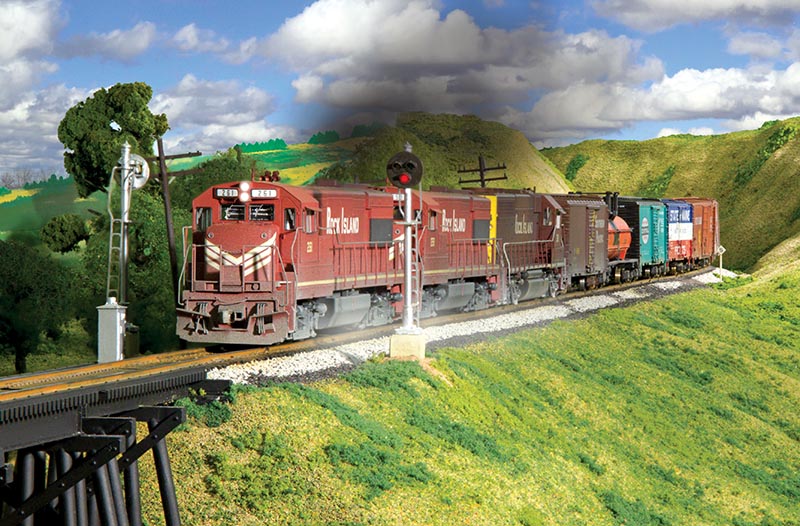
ABOVE: Train 67 exits a deep cut south of Des Moines, Iowa. Two GE U28Bs and an EMD GP40 are in charge of this mixed freight on this glorious summer day.
The Territory
Nevada, Iowa, is located on what was the Rock Island’s Mid-Continent Route extending from the Twin Cities to Houston-Galveston. Today this route is referred to as the Spine Line. I decided to model the Midwest portion of the Mid-Continent Route from the Twin Cities to Kansas City. The Rock Island’s major yard in the Twin Cities is Inver Grove Yard and the major yard in Kansas City is Armourdale Yard. Choosing this segment allowed me to model a relatively flat railroad with several cuts and fills, a number of culverts, and a few bridges spanning creeks and rivers. Nothing dramatic in terms of scenery, just a typical Midwestern look.
Other yards modeled on the layout include Union Pacific’s Armstrong Yard in Kansas City, Chicago Great Western’s Ohio Avenue Yard in Kansas City, the Minnesota Transfer Yard in Minneapolis, and small yards at Trenton, Albert Lea and Clear Lake Junction.
Industries on the layout include a meat packing plant, cement plant, grocery distributor, grain elevators, fertilizer distributors, cold food storage, a newsprint warehouse, a freight transfer facility, and a couple of team tracks.
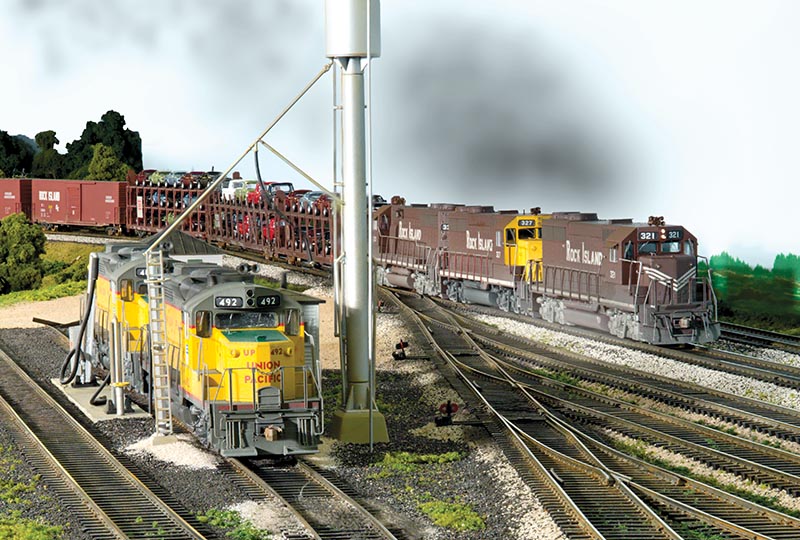
ABOVE: A trio of EMD GP35s thunder past Union Pacific’s Armstrong Yard in Kansas City with some high-value revenue in tow. The Rock Island crossed many other Midwestern railroads, giving the opportunity to model foreign interchanges and equipment.
Construction
Layout construction started in 2007 when we moved into our newly constructed home. A 30×40’ room on the second floor was specifically designed to accommodate the dream model railroad that I had envisioned for many years. I have built eight layouts through the years, but I must admit that the first four were built during my childhood and teenage years and weren’t much to write home about. The quality of the last four layouts has incrementally improved and I believe I can say that the current Mid-Continent Route is likely the final layout for me.
It took me about eight years to complete the single-track, double-decked Mid-Continent Route. I used a robust cantilevered wood brace system for both levels which are positioned 40” and 60” above the floor. This bracing system allowed me to eliminate the need for any legs below the layout. Benchwork is open-grid construction with risers for positioning and securing the roadbed. Two helixes provide the transition from one level to the other. The helixes contain double track with one track being the main line and the second track providing a siding for meeting and passing trains.
The only grade of significance on the layout is 2 percent located in both of the helixes.
I have modeled eight towns on the Mid-Continent Route. I originally intended to model a few more towns, but decided against it in favor of more open space allowing for wide-open rural train operations. The main line run is 777 feet (this includes the two helixes) and it takes a train about 20 minutes to make a complete trip around the layout. Typical freight train length is about 35 cars…
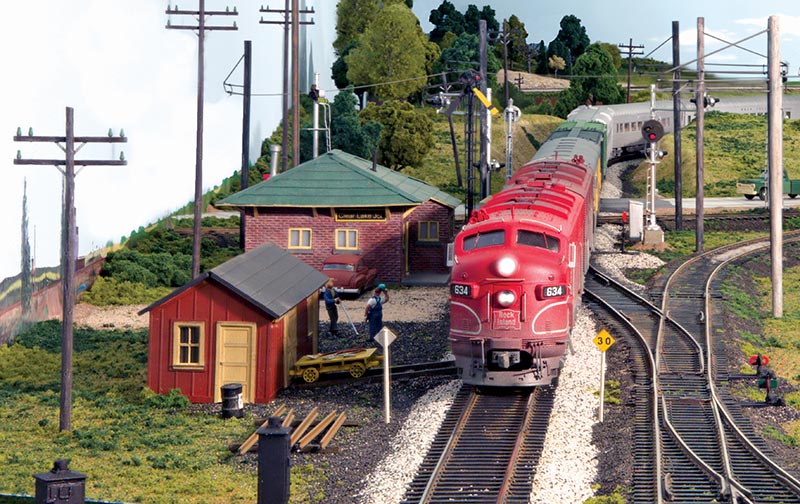
ABOVE: Northbound passenger Train 18 hammers across the Iowa Terminal Railroad diamond at Clear Lake Jct., Iowa. The Rock Island has trackage rights over the Chicago Great Western Railway at this location.


